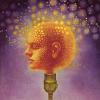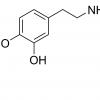INDIVIDUAL ABSTRACT:
A PHASE 1B, RANDOMIZED, DOUBLE-BLIND, PLACEBO-CONTROLLED,
MULTIPLE-DOSE ESCALATION STUDY EVALUATING THE EFFECTS OF NSI-189
PHOSPHATE, A NEUROGENIC COMPOUND, IN PATIENTS WITH MAJOR
DEPRESSIVE DISORDER (MDD)
1 2 3 4 5
Maurizio Fava , Karl Johe , Lev Gertsik , Larry Ereshefsky , Bettina Hoeppner , Martina
6 7 7 8
Flynn , David Mischoulon , Gustavo Kinrys , Marlene Freeman
1Massaschusetts General Hospital Department of Psychiatry, 2Neuralstem, Inc., 3California
Clinical Trials Medical Group, 4PAREXEL International, 5Harvard Medical School,,
6 7
Massachusetts General Hospital Clinical Trials Network and Institute, Massachusetts General
Hospital, Harvard Medical School, 8Massachusetts General Hospital
NSI-189, a benzylpiperizine-aminiopyridine, is a novel chemical developed by Neuralstem Inc.
for the treatment of major depressive disorder, based on preclinical evidence of neurogenesis in
human hippocampus-derived neural stem cells in vitro and in mouse hippocampus in vivo. NSI-
189 has also shown behavioral efficacy in the novelty suppressed feeding after daily oral
administration for 28 days. This is an early phase, double-blind, randomized, placebo-controlled,
multiple-dose study with three ascending cohorts. The first cohort received 40 mg QD, the
second cohort 40 mg BID, and the third cohort 40 mg TID. 24 patients with major depressive
disorder (MDD) were recruited, with their diagnosis and illness severity confirmed through an
independent, remote SAFER interview from the MGH CTNI raters. Each cohort included at least
3 female subjects. Each patient underwent a Screening for eligibility (Day -37 to Day -6 or -3)
and eligible patients were admitted into the unit on Day -5 to complete their wash-out and be
reconfirmed for eligibility and for baseline assessments. Eligible patients receive daily dosing of
investigational medicinal product (NSI-189 Phosphate or placebo) for 28 days starting on Day 1
and were followed for safety, PK, and PD until discharge. At the conclusion of in-house dosing
(Day 28), patients remained in the unit for up to 3 additional days, at the psychiatrist’s discretion.
On Day 35 (± 3), Day 42 (± 3), Day 49 (± 3) and Day 70 (± 3) outpatient follow-up visits took
place. Patients returned to the unit for extensive follow-up on Day 56 (± 3) and Day 84 (± 3)
(End-of-study). The efficacy assessments included the Montgomery-Asberg Depression Rating
Scale (MADRS), the Clinician Global Impression – Improvement (CGI-I), the Symptoms of
Depression Questionnaire (SDQ) and the Cognitive and Physical Functioning Questionnaire
(CPFQ). Despite the minimal improvement observed among the placebo-treated patients, at day
28, the efficacy measurements showed a clinically meaningful reduction in depressive and
cognitive symptoms across all measures for the two lower doses (40 mg/day and 80 mg/day) but
not for the highest dose (120 mg/day). These improvements appeared to persist over time during
the follow-up for MADRS, SDQ, and CPFQ. In terms of safety, no serious AEs occurred and the
drug was well tolerated. The main limitations of this study are the relatively small sample size of
each cohort and the fact that efficacy analyses were not the primary aim, and were meant to be
only descriptive in nature. In summary, a novel neurogenic compound, NSI-189, has shown
promise as a potential treatment for MDD in a Phase 1B, double-blind, randomized, placebo-
controlled, multiple-dose study with three ascending cohorts. These preliminary findings support
the view that a neurogenesis-based platform can identify promising new treatments for MDD
(Fava et al, 2012). The possible inverted U dose-response curve observed in this study is
consistent with previously reported inverted U dose-response curve of compounds enhancing
synaptic plasticity (Lavergne and Jay, 2010). Further studies are necessary to confirm these
preliminary observations.
Learning Objectives:
To learn about the potential usefulness of novel neurogenic compounds in depression.
To learn about the safety and efficacy of NS189 in the treatment of depression.























































